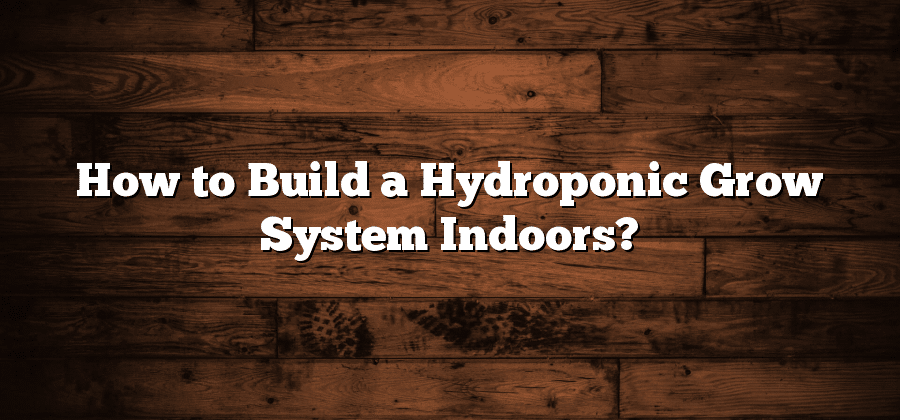Materials Needed for Indoor Hydroponic System
To set up an indoor hydroponic system, there are several materials you’ll need to gather in order to ensure optimal plant growth and health. First and foremost, you’ll need a grow tent or a dedicated space with controlled environmental conditions. This will protect your plants from external factors such as pests and temperature fluctuations.
Next, you’ll require a hydroponic reservoir to hold the nutrient solution that will provide essential minerals to your plants. This can be a simple plastic container or a more advanced system with built-in pumps and sensors. Additionally, you’ll need an air pump to provide oxygen to the roots and promote healthy growth. Other essential materials include grow lights to simulate sunlight, growing trays to hold the plants, and a pH meter to monitor and adjust the acidity levels of the nutrient solution.
In terms of supplies, you’ll need a growing medium such as rockwool or coco coir, which will support the plants and retain moisture. Nutrient solutions specifically formulated for hydroponics are also crucial to provide the essential elements necessary for plant development. Lastly, make sure to have basic gardening tools like pruning shears and a sprayer for watering the plants.
With these materials in place, you’ll be well-equipped to create a thriving indoor hydroponic system. However, it’s important to note that the specific materials you’ll need may vary depending on the size and complexity of your setup, as well as the specific plants you plan to grow.
Choosing the Right Location for Your Hydroponic System
Choosing the right location for your hydroponic system is crucial for the success of your indoor gardening endeavors. There are a few key factors that you need to consider in order to create the optimal environment for your plants to thrive. Firstly, you want to choose a location that receives ample natural light. Ideally, your hydroponic system should be placed near a window or in a room with good exposure to sunlight. This will provide your plants with the necessary light energy they need for photosynthesis, promoting healthy growth and productivity.
In addition to light, another important factor to consider is temperature. Your hydroponic system should be placed in a location with stable temperature levels. It is recommended to maintain a temperature range between 65-75°F (18-24°C) for most hydroponic plants. Extreme temperature fluctuations can negatively impact plant growth and can even lead to plant stress or damage. Therefore, it is important to avoid placing your hydroponic system near heating or cooling sources, such as radiators or air conditioning vents, as these can cause temperature imbalances.
Understanding the Basics of Hydroponic Systems
Hydroponic systems are becoming increasingly popular for indoor gardening enthusiasts. However, before diving into this unique method of cultivation, it is essential to understand the basics of how hydroponic systems work.
At its core, hydroponics is a soilless gardening technique that allows plants to grow in nutrient-rich water rather than traditional soil. This specialized system relies on a combination of water, essential nutrients, and oxygen to provide optimal growing conditions for plants. Unlike conventional gardening methods, hydroponics offers precise control over environmental factors such as temperature, pH levels, and nutrient concentration. By creating a controlled environment, hydroponic systems can help plants grow faster, produce higher yields, and conserve water compared to traditional soil-based gardening.
With a solid grasp of the fundamental principles behind hydroponics, beginner gardeners can venture into this exciting world of innovative cultivation practices. Understanding how hydroponic systems work will serve as a solid foundation for choosing the right system for your needs and selecting the most suitable plants to thrive in this unique growth environment.
Selecting the Best Plants for Your Indoor Hydroponic System
When it comes to selecting the best plants for your indoor hydroponic system, there are several factors to consider. First and foremost, you need to think about the space available in your system. Some plants, such as lettuce and herbs, are ideal for smaller setups due to their compact size. On the other hand, larger plants like tomatoes or peppers may require more spacious grow beds. Additionally, you should consider the growth characteristics of the plants you are interested in. Fast-growing plants with shallow root systems, such as leafy greens, are often easier to manage in a hydroponic system compared to plants with deep and extensive root systems. This is because hydroponics relies on a nutrient-rich water solution that needs to reach the roots efficiently. Therefore, plants with extensive root systems may require more complex hydroponic setups to ensure proper nutrient delivery.
Constructing the Hydroponic Grow Bed
When it comes to constructing the hydroponic grow bed for your indoor hydroponic system, there are a few key considerations to keep in mind. Firstly, you’ll need to choose the right material for the bed itself. Common options include plastic, wood, or even metal. Each material has its own advantages and drawbacks, so it’s important to weigh them carefully before making your decision. Additionally, you’ll also need to select an appropriate size for the grow bed, taking into account the space you have available and the number of plants you plan to grow. Remember to leave enough room for the plants to spread their roots and to access water and nutrients.
Once you’ve chosen the materials and determined the size, the actual construction process can begin. Start by assembling the frame, ensuring it is sturdy and level. From there, you’ll need to install the growing media. Popular options include perlite, vermiculite, or coconut coir, among others. Make sure to evenly distribute the media throughout the bed and create a level surface for your plants to grow on. Lastly, you’ll need to install the irrigation system and reservoir. This will ensure a constant supply of water and nutrients to your plants, promoting healthy growth and high yields.






